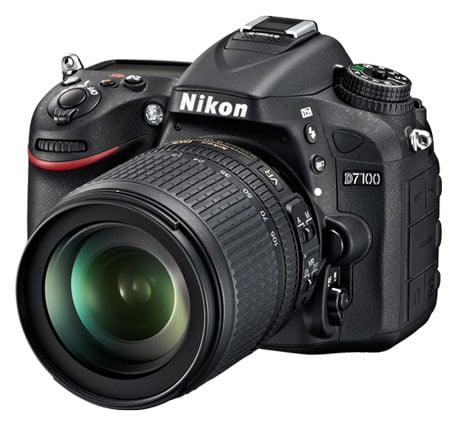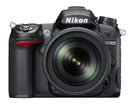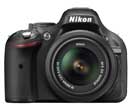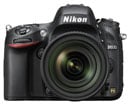Nikon D7100 review
-
-
Written by Ken McMahon
Verdict
The Nikon D7100 is Nikon’s replacement for the ageing D7000 and, in the absence of a replacement for the D300s, becomes Nikon’s flagship DX camera. Officially it sits between the D7000, which remains in Nikon’s line-up, and the full-frame D600.
There’s been much anticipation regarding the D7100’s image quality, due to Nikon’s decision not to employ an optical low-pass filter to reduce moiré patterns in images. But from my tests it looks like the difference this makes is, in most circumstances, fairly negligible. But don’t let that put you off, the D7100 still produces excellent quality 24 Megapixel images that are an improvement on those of its predecessor. Significantly though, it does mean you can achieve practically the same image quality from the much lower priced D5200.
Of course, there’s more to the D7100 than just the sensor and its absent filter. This is a camera designed to appeal to demanding enthusiasts. The improvements that Nikon has made, including a more sophisticated 51-point AF system that works down to f8, five-frame exposure bracketing, improved continuous shooting, a bigger brighter LCD screen, improved viewfinder information display, upgraded moisture and dust sealing and improved handling, are all designed to appeal to exactly that market, and for videographers the new video modes, built-in stereo mics and a headphone jack will be welcome additions.
For existing Nikon DX owners the D7100 remains a very attractive upgrade option. Leaving the D7000 aside for a second, the interesting thing is that while there are compelling alternatives to the D7100 within the Nikon line-up, there’s nothing that competes with it as a viable alternative. Which of course is exacly what Nikon intends. The D5200 may, in practical terms match it for image quality, but can’t compete with its build quality or superior handling. As for the D7000, it’s looking very good for its age with image quality that can hold its own with newer models and a feature set that has a lot in common with its replacement. So I don’t imagine too many D7000 owners wlil be rushing to trade-in for the newer model, but that’s not to say the D7100 doesn’t have plenty to attract upgraders from the lower echelons of Nikon’s consumer range. If you’re still undecided, take a look at my comparisons below with the D7000, D5200, D600 and D300s. What’s that? You also want a comparison with a Canon DSLR? While the D7100 slots between the existing EOS 60D and 7D, I’m holding back on a detailed comparison until rumours of a near successor to one or the other is confirmed. So for now let’s see how it compares to other Nikon bodies.
 |
Compared to Nikon D7000
 | ||
The Nikon D7100 slots between the D7000 and the D600, so I’ll start by comparing it to the former. The D7000 was launched two and a half years before the D7100, but redefined what we could expect from a mid-range DSLR, borrowing many features from the semi-pro market. As such even though it’s fairly old in digital terms, its feature set remains very respectable.
I’ll start with what both the D7000 and D7100 share in common. Nikon may be talking about how the D7100 is light and compact, but referring to the company’s vital statistics, they’re essentially the same size and weight with only a few millimeters and grams between them. Both models sport viewfinders with 100% coverage and essentially the same magnification. Both also have twin SD memory slots, although Nikon now quotes compatibility with UHS cards for the D7100. Both have the same continuous shooting speed at their maximum resolutions of 6fps, although obviously the D7100 is processing more pixels per frame (resulting in a smaller RAW buffer) and offers a higher speed option in the crop mode. In testing, though, the D7100 could shoot a much longer burst of JPEGSs at full speed and managed a respectable 4.6fps even when the buffer was full.
Both share the same 100 to 6400 ISO sensitivity range with expanded options of 12800 and 25600 ISO. Both offer 1080p movie recording at 24fps, although the D7100 additionally offers 25p and 30p options as well as 720p50 and 60, along with a 1080i option with a further crop. Both share the same 2016 pixel RGB metering sensor, and both also use the EN-EL15 battery, although under CIPA conditions the D7000 squeezes about 10% more shots per charge.
So there’s a fair amount in common between the two models, but the D7100 enjoys a number of key upgrades. Most obviously the resolution is now 24 Megapixels versus 16 on the old model. The absence of a low pass filter on the D7100 should in theory allow it to unlock a higher degree of sharpness per pixel, but in my tests the quality difference wasn’t as big as you might expect. The D7100 also offers an additional 1.3x crop mode, delivering 15.4 Megapixel images with an effective field reduction of two times and a small boost in continuous shooting to 7fps. So the crop mode effectively delivers images with the same resolution as the D7000 but with a further 1.3x crop which is good news for wildlife and sports photographers. The 7fps speed also matches the speed of the D300s, and the D7100 comfortably out-resolves its 12 Megapixels whether cropped or not.
Speaking of the D300s though, the D7100 now inherits an enhanced version of the Multi-CAM 3500DX autofocusing sensor, boosting the number of AF points to 51 with 15 cross type sensors over the 39 point / 9 cross-type system of the D7000. It also works under dimmer lighting and at apertures of f8 which is handy when using teleconverters.
HDR fanatics will be delighted to find the D7100 now offers up to five-frame bracketing compared to just two or three for the D7000. Moving onto movies, the D7100 now offers 1080p at 24, 25 and 30p rather than just the 24p of its predecessor. It also has built-in stereo microphones along with a new headphone jack in addition to an external microphone input, but loses the analogue A/V out port of the D7000.
Physically both the D7000 and D7100 employ magnesium alloy rear and top panels, although Nikon claims the sealing is better on the new model and to the same standard as the D800. This is a hard one to test, but it certainly sounds like the D7100 will fare better in bad conditions. I can testify that the D7100 survived a couple of minutes in quite a heavy rain shower with no ill effects.
The D7100’s screen is a little larger at 3.2in versus 3in, it doesn’t sound like a lot, but it makes a bigger difference than you’d think. While the resolution remains 4:3 shaped VGA with 640×480 full colour pixels, the actual colour arrays on the D7100 now feature an additional white dot to deliver a brighter image. Sadly it remains fixed in place though while Canon’s EOS 60D and Nikon’s own D5200 sport articulated monitors.
The exposure range and flash sync remains the same, but a nice upgrade that will be welcomed by HDR enthusiasts is deeper bracketing of 2-5 frames in steps up to 3EV apart, compared to 2-3 frames up to 2EV apart on the D7000. The D7100 also gets the same 2-shot HDR composite mode as on the D5200.
Overall the D7100 sports a lot of upgrades over its predecessor, although some of them are quite minor and may or may not be key factors for you personally. Of all the upgrades, the higher resolution sensor without the low pass filter and the superior weather-sealing are arguably the most important, which coupled with the other enhancements could easily draw people to the new model, especially if they’re new buyers or upgrading from a lower model in the range.
But comparing the specifications just confirms how capable the earlier D7000 remains in today’s market and why Nikon has chosen to keep it in the range. Those who don’t need 24 Megapixels or 1080p at variable frame rates and are satisfied by the D7000’s build quality could bag themselves a bargain.
See my Nikon D7000 review for more details.
Compared to Nikon D5200
 | ||
The D5200 is a mid-range DSLR that sits between the D3200 and the D7000 in Nikon’s consumer DSLR line-up. As such it’s considerably cheaper than the D7100, a model with which is has a lot in common, not least the 24 Megapixel CMOS sensor and Expeed 3 processor. The main difference here is that the D7100 lacks the optical low pass filter that in the D5200 helps to mimimise moiré patterns in fine texture and patterned detail. In my tests the D7100 didn’t suffer noticeably more with moiré than the D5200, but neither did it produce significantly sharper or more detailed images, so there’s actually very little to choose between these two models in terms of image quality.
With Magnesium alloy top and rear panels and moisture and dust sealing, the D7100 is tougher and more durable, it’s also bigger and a lot heavier at 756g compared with 555g for the D5200. And if looks are important to you, the shiny plastic body of the D5200 looks more consumer and less professional than the matt and rubberised surfaces of the D7100.
With a pentaprism providing 100 percent coverage the D7100 provides a bigger, brighter view through the viewfinder than the penta-mirror system of the D5200 with 95 percent coverage. It also has a bigger 3.2 inch LCD screen with 4 dots per pixel, adding a white dot to the RGB array to produce a brighter image. Against that, the D5200’s 921k dot (the same resolution as the the D7100’s but without the fourth white dot) is articulated with a side-hinge and can be folded out to face in any direction or in on itself for protection.
The D5200’s AF system, upgraded to match that of the D7000 has 39 points with 9 cross-type sensors. The D7100 has moved on too though, with a 51-point system boasting 15 cross-type sensors with a central cross-type point that’s sensitive at apertures down to f8 – useful for shooting with a teleconverter attached. And If you have a collection of older Nikon AF lenses you’ll be reduced to manual focus on the D5200 which lacks a built in AF motor, whereas you’ll still be able to use AF on the D7100.
Both models provide the full rage of PASM shooting modes, the D5200 is a little more novice-friendly with scene presets on the mode dial, but you might just regard this as so much clutter. The D7100 offers slightly faster continuous shooting at 6fps (plus 7fps in 1.3x mode) compared to 5fps on the D5200. It also has more versatile auto exposure bracketing with a maximum of five frames versus three. While it shares the same extended 100-25600 ISO range the D5200’s fastest shutter speed is 1/4000 compared with 1/8000 on the D7100. However the D5200 shares the D7100’s HDR mode, interval timer, and Active D-lighting features.
For movies, both offer similar video modes including the 1.3x sensor cropped 1080i50/60 mode, although the D5200 lacks the D7100’s 1.3x crop for stills. Both are equipped with built-in stereo mics as well as a 3.5in socket for connecting an external mic. Both also provide an uncompressed video feed via the HDMI port without overlays so can be used with an external monitor or for high quality capture using an external device. The D7100 has the advantage of a headphone socket for sound monitoring though.
With so many features in common, what really separates these two models is build quality and handling. What you don’t get with the D5200 is the ruggedness and weather sealing of the D7100, nor its twin memory card slots, bigger viewfinder or deeper bracketing. It also lacks many of its physical controls, most notably two command dials and a drive mode dial, making crucial operations incuding AF mode selection, ISO sensitivity, auto bracketing and so on a little less immediate. But if you can live without those refinements it represents excellent value for money, especially with such similar image quality coupled with the articulated screen.
See my Nikon D5200 review for more details
Compared to Nikon D600
 | ||
Nikon’s official line is that the D7100 slots between the D7000 and D600 in the range and describes the new model as being the best that the DX format can offer. From that statement you can surmise a D300s successor remains unlikely and anyone wanting a semi-pro DSLR from the company should go full-frame, starting with the ‘budget’ D600. While the D600 obviously enjoys the benefits of a bigger sensor though, there are also compelling features the D7100 has in its favour.
But first, there’s a number of things both have in common, including 24 Megapixel resolution, 100% viewfinder coverage, 3.2in screens, 1080p movie modes at 24, 25 and 30p, microphone and headphone jacks, and twin SD card slots. Now for the differences.
The D7100 may be positioned below the D600, but enjoys a more sophisticated AF system with 51 points and 15 cross-type sensors compared to 39 points and nine cross-type sensors. Switch the D7100 to its 1.3x crop mode and these 51 points also virtually fill the frame, making it great for tracking erratic subjects right up to the edges and into the corners. The D7100 also boasts slightly faster continuous shooting of 6fps compared to 5.5fps on the D600, in addition to a 7fps option in its crop mode. Interestingly the D7100 also enjoys a faster maximum shutter speed of 1/8000 and flash sync of 1/250 compared to 1/4000 and 1/200 on the D600. The D7100 additionally features deeper bracketing with up to five frames 3EV apart compared to three frames up to 2EV apart. In terms of build quality, the D7100 sports better weather sealing compared to the D600 and also has a brighter screen, built-in stereo microphones in addition to being a bit smaller and around 100g lighter. Finally the D7100 costs comfortably less than the D600.
The D600 is all about the benefits of having a bigger full-frame sensor. The resolution and sensitivity range may be the same, but the larger pixel pitch should mean lower noise and higher dynamic range in the D600’s favour. It also means having a much larger image through the viewfinder along with no field or depth-of-field reduction factor on lenses. This is however the only major benefit the D600 has over the D7100, so let’s look closer at the implications of the bigger sensor.
You’d assume the D600 will deliver superior image quality to the D7100, but while this will almost certainly be the case at higher sensitivities, it’ll be an interesting comparison at lower ISOs where the absence of a low pass filter on the D7100 might actually allow it to deliver sharper images. I’ll update this review with a detailed comparison when I have a chance to test both models side by side. Having said that, in my tests alongside the D5200, the D7100’s sensor failed to deliver the anticipated improved sharpness over that model.
There’s also the field and depth-of-field reduction to consider as the argument between FX and DX actually works both ways. The full-frame D600 may enjoy a lack of crop factor and a big viewfinder image, but anyone shooting small or distant subjects may prefer the DX crop; some may also prefer the larger inherent depth-of-field. If you currently have a collection of DX lenses, it’s also nice to use them with 24 Megapixels on the D7100, whereas the D600 will deliver a smaller image size with DX lenses. Then there’s that price factor again.
But for some the lure of full-frame will be enough to tip them towards the D600, and while the D800 is closer to the non-sensor specs of the D7100, its cheaper counterpart remains a highly compelling option.
See my Nikon D600 review for more details.
Compared to Nikon D300s
 | ||
Anyone waiting for a D400 will no doubt be dismayed that the ‘mid-range’ D7100 is being described as the best that DX can offer, but the new DSLR actually comes closer to being a semi-pro D300s successor than first appears.
I’ll start again with what they both have in common: 100% viewfinder coverage, twin memory card slots (although the D300s has one CF and one SD versus two SD on the D7100), a 51-point AF system (although the D7100 is a little more sensitive), external microphone inputs, and screens with VGA colour resolution.
In its favour the D7100 boasts double the total pixel count (24 Megapixels vs 12) along with the benefit of no low pass filter. Some may believe the broader pixel pitch of the D300s may give it a benefit at higher sensitivities, but four years have passed between these models with sensor technology greatly improving with each generation. I’d be surprised if the D7100 doesn’t comfortably beat the D300s in quality, although I’ve not yet made a side-by-side comparison. The D7100 also has a much more sophisticated movie mode with 1080p capabilities, an external headphone jack, built-in stereo mics, and a stab at continuous autofocusing. The screen is bigger (3.2in vs 3in) and brighter thanks to an additional white dot at every pixel.
In its favour, the D300s sports all magnesium alloy construction making it tougher (albeit heavier) than the D7100, although the weather sealing is described as being the same. The continuous shooting speed is a tad faster at 7fps (vs 6fps) at the full resolution or 8fps with the battery grip, and the right batteries, although to be fair, the 1.3x cropped mode of the D7100 delivers 7fps and still delivers images with slightly higher resolution. The buffer is however deeper on the D300s, recording 41 Large Fine JPEG or 18 RAW files in my tests, which will at least 50% more than the D7100 – although again to be fair the D7100 is recording double the number of pixels on each frame.
The bracketing is deeper too with up to nine frames on the D300s versus five on the D7100, although the D300s can only separate them by up to 1EV, whereas the D7100 can manage 3EV between its five frames for a broader total range. Finally the D300s confirms its semi-pro status with a PC Sync port for connecting to external lighting, although again the D7100 enjoys its own connectivity advantages.
So overall the D300s is potentially tougher (although equally sealed), has a PC Sync port, deeper bracketing and can shoot slightly faster and for slightly longer. But that’s about it. Written down, the D7100 is a superior choice for all but those who intend to bash their camera around and connect it to external lighting. But the D300s is available for comfortably less than the D7100 so while it’s of little consolation for existing owners looking to upgrade to a modern semi-pro DX body, it could prove a bargain buy for aspiring sports photographers on a tighter budget. It’s also interesting to see it costs roughly the same as a D7000.
See my Nikon D300s review for more details.
Nikon D7100 final verdict
The Nikon D7100 is a worthy successor to the D7000 and a sufficiently capable camera to fill the vacancy at the top end of Nikon’s DX range for all but the pro sports photographers or studio strobists out there. Perhaps understandably, a lot of the attention it has received since its launch has focused on its absent optical low-pass filter, with inflated expectations of a resultant boost in sharpness and definition. It now looks like any resulting increase in quality over the company’s other 24 Megapixel DX bodies is at best, marginal, and many will no doubt be disappointed by that. But don’t lose sight of the fact that OLPF or not, the D7100’s sensor produces superb quality 24 Megapixel images; it’s just that they’re really close to what the cheaper D5200 delivers.
Where it matters to advanced enthusiast and semi-pro users though, the D7100 delivers, with enhancements to build quality and handling, more capable AF and improved continuous shooting, deeper bracketing, a bigger screen and new shooting modes including HDR and effects filters. There’s also something to tempt videographers, with new movie modes, built-in stero mics and a headphone socket.
Seen in isolation, these refinements may look like small beer, but they add up to an evolutionary upgrade that makes perfect sense for shooters looking for the most robust and capable DSLR they can buy without committing to the size, weight and expense of a full-frame body.
Ultimately the biggest problems for the D7100 come from within Nikon’s own DSLR range. There’ll be those who, as discussed earlier, had hoped for a boost in quality over the company’s other 24 Megapixel DX-format models like the D5200, and be disappointed to discover there’s barely any difference in practice. Maybe the D5200’s low pass filter already was fairly mild. Then there’ll be those who are still waiting for a D400, and despite the D7100 out-speccing the D300s in almost every respect, it remains a mid-range, not a true semi-pro body. Then there’s the earlier D7000, which raised the bar so high on release that it’s still a serious contender today.
So by not beating the D5200 on quality, not becoming a D400, and not significantly out-doing the D7000, it’s easy to become a little blasé about the D7100. But this would be doing it a huge disservice. It really is an excellent DSLR with a broad feature-set and great image quality, and as such is easy to Highly Recommend. There’s no doubt it will sell very well, but I also believe it’ll drive sales of the D5200 for those who desire the D7100’s quality in a simpler and more affordable package, not to mention the earlier D7000 for those who want much of the D7100’s feature-set and handling again at a cheaper price. Now it only remains to be seen what, if anything, Canon has up its sleeve for a possible 60D and 7D successor.
|
Good points Excellent quaity and high ISO noise performance. 51-point AF system which works at f8. Dust and moisture sealed body. 1.3x crop mode. Built-in stereo mics and headphone socket. Bad points 
| Scores (relative to 2013 upper mid-range DSLRs) | |||
Build quality: Image quality: Handling: Specification: Value: Overall:
|
17 / 20 18 / 20 17 / 20 17 / 20 16 / 20 85% | |||




